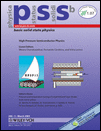Polarized Raman study of self-assembled Ge/Si dots under hydrostatic pressure
Abstract
We have studied the correlation between the morphology of Si-capped Ge islands grown on Si substrates and their vibrational properties as measured by Raman scattering at ambient and under high hydrostatic pressure. For this study we have grown by molecular beam epitaxy a sample that exhibits a size distribution with two distinct island types having different aspect ratios called pyramids and domes. In accordance, Raman spectra show a double-peak structure at the frequencies of the Ge–Ge vibrational mode (∼300 cm–1) as well as for the Si–Ge mode (around 400 cm–1). Pairwise, different selection rules have been found for these modes depending upon the Raman polarization configurations, suggesting a correlation between both Ge dot sizes and the double peak structure in the Raman spectra. Finally, a different strain status of the dots was observed by studying the pressure coefficient of the Ge–Ge phonon mode, resulting in a value of 3.3 and 3.6 cm–1/GPa for pyramids and domes, respectively. The main conclusion of our work is that the double-peak structure observed in Raman spectra is indicative of a bimodal dot size distribution in contrast with what is proposed in previous work within the so-called core-shell model [M. Y. Valakh et al., Nanotechnol. 16, 1464 (2005)]. (© 2009 WILEY-VCH Verlag GmbH & Co. KGaA, Weinheim)




